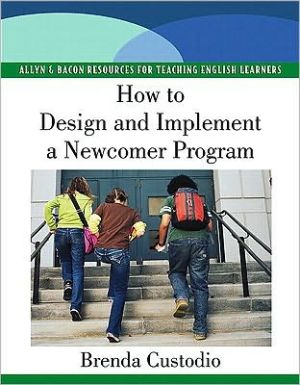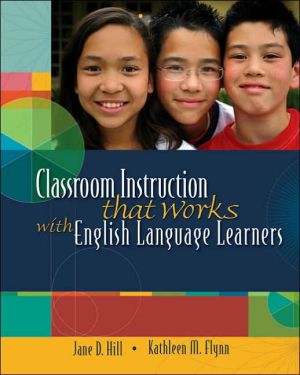How to Design and Implement a Newcomer Program
*************DRAFT COPY *************\ Brenda Custodio on the pressing need for newcomer programs.\ (Pearson please note: author asked for the copy in italics to be included on the back cover copy.)\ While the atmosphere and focus of education has changed to center strongly on standards and assessment, there is still room for programs that focus on meeting the needs of beginning level ELLs. In fact, it can be argued that this sense of desperation and frustration adds urgency to the creation...
Search in google:
In this unique, first-of-its-kind look at an increasingly popular educational model–the newcomer program–author Brenda Custodio brings over 25 years of ESL experience and nine years of newcomer program development to this practical resource. In it she shows what’s needed to design and implement the program, prepare the site, develop the curriculum, interview and hire staff, and continually build a constantly evolving, successful newcomer program based on learners’ needs.
TABLE OF CONTENTS Description of Newcomer Programs / History and RationaleDescription and History of Newcomer ProgramsDemographic data on numbers of ELLs and recent arrivalsReview of newcomer program historyRationale for Newcomer ProgramsIncrease in students with limited literacy skillsIncrease in gap between students’ abilities and school expectations2. Getting StartedFactors to consider when determining if a newcomer program is right for your districtNumber of new arrivals each yearRate of arrivalAbility of district to absorb these arrivals into existing programsAge and previous education of new arrivalsFamily and community support availablePrimary language of new arrivalsSupport required by district and communityDistrict resources available (finances, staff, building, knowledge)District philosophy considerations (i.e., neighborhood schools, busing and magnet schools, inclusion vs. separate programming, language programming)Issues to be determined before openingHow to handle continual new enrollment during the school yearWhat to do when capacity is reachedHow to provide for extracurricular activitiesHow to service students with special education needsSteps in designing and implementing a newcomer programExploration stagePlanning and implementing stagesCenter of Applied Linguistics Checklist Program Design OptionsCriteria for selection of program designPrevious educational experience of newcomersLocation of new arrivalsAge of new arrivalsDistrict philosophy of language instructionDistrict resourcesStructural and curricular design optionsSchool-within-a-school or separate siteLength of program (semester to multiple years)Transition or exit planCurricular or grade level optionsSingle or multiple school districtsAdditional support services (tutoring, after-school, summer)Language Instructional options —BilingualTransitional bilingualMaintenance bilingualDual language programsHeritage language programsESLStructured immersionContent-based ESLSheltered instruction Student placement and exit criteriaGovernment guidelines for placement and serviceLau v NicholsPlyler v DoeCastaneda v PickardLanguage proficiency testingPre-testing and placement of studentsAssessment tools for placement, transition, and exitingEnglish proficiencyNative language proficiencyMath proficiencyDefinition of “newcomer”Language services continuumIntake CentersRole of intake centerServices provided:Interpreters, document translation, health screenings, connection to district and community services, placementExit processWhen and how leave the newcomer centerMethod of mainstreaming/ transition plan (gradual or upon completion) Newcomers with limited formal schoolingDescription of students with limited formal schoolingVarious terms or labels used in academic literatureWhat constitutes limited formal schoolingCauses of limited formal schoolingMigrant studentsLatinos and other students from rural areas or areas with civil unrestRefugeesEducational time lost while acquiring EnglishChoiceEducational issues associated with limited formal schoolingLimited time to complete educationLimited literacy skillsLimited exposure to content area subjectsLimited numeracy skillsLimited knowledge of school expectationsAcademic focus for limited formal schooling studentsLiteracy developmentSheltered content instructionMath skills developmentBasic school orientation Literacy development for newcomer ELLsCritical nature of literacy skillsComponents of an effective literacy program§ Introduction to and practice with basic reading skills§ Knowledge of high-frequency words§ Development of extensive vocabulary§ Activities to develop fluency and comprehension in reading and writing§ Integration of all four language skills from the start§ Knowledge of strategies to monitor comprehension§ Practice with graphic organizers§ Experience with various genres and purposes§ Opportunities for daily reading and writing§ Opportunities for independent reading and writing§ Practice with the writing process§ Knowledge of study skills§ Experience with instructional or grade-level material§ Reading and writing for pleasure and life-long learnersScaffolding literacy development Numeracy development for newcomer ELLsCritical nature of numeracy skillsComponents of an effective numeracy programNumbers§ Cardinal§ Money§ Time/calendars/dates§ Place value and use of commas§ OrdinalsOperations and basic skills§ Addition§ Subtraction§ Multiplication§ Division§ Rounding and estimating§ Positive and negative integers§ Fractions, decimals, and percentsMeasurement§ Length, weight, volume, and temperature§ Perimeter, area, and volume§ Standard and metricOther math skills§ Data analysis (charts, graphs, and tables)§ Prime numbers, factors, and exponents§ Basic geometry§ Ratio and proportion§ Pre-algebra§ Word problemsStrategies for numeracy development Instructional strategies/models for NewcomersStrategies for skills developmentBuild background knowledgeProvide comprehensible inputActivate and build on prior knowledgeUtilize manipulatives, realia, and visualsExplicit skills instruction (CALLA)Teach specific reading comprehension strategiesIntegrate four areas of language skillsModel lessons and scaffold activitiesProvide multidisciplinary theme units (content-based instruction)Utilize cooperative learning groupsDevelop effective questioning techniquesFocus on vocabulary development in all subject areasUsing the SIOP Model for sheltered instruction classes Curriculum development and materials selectionCurriculum§ Orientation as part of curriculum§ Curriculum modification§ Courses for high school credit§ Career preparation and trainingMaterial selection§ Criteria for textbook and supplementary material selection§ Types of textbook and supplementary material available§ List of resources/publishers for Newcomers Assessment for NewcomersInitial placement assessment (discussed earlier)Classroom informal and formal assessmentsPortfolio assessmentPerformance assessmentOral assessmentChecklistsEmbedded assessmentGrading issuesFormal assessmentStandardized testing issuesAssessment for placementspecial educationgifted and talentedcollege entrance exam Newcomer programs and standards-based instructionAffects of NCLB on Newcomer Schools§ Highly-qualified teachers§ Intensive and extensive professional development§ AYP goals and ramifications§ Disaggregated sub-group data (including LEP)§ Annual English language proficiency testing with goals§ High school cohort regulationsStandards-based instructionContent and language objectivesCurriculum laddersIntegrating state and national English language development standardsTeaching test-taking strategies Staffing and administrationState requirements for certification/licensureStaff selectionPersonality disposition for working with NewcomersProfessional development (upon entry and on-going)What teachers need to know about their studentsPrimary languageHome countryBasic knowledge of the culturePrevious educational backgroundFamily situationPersonal interestsBasic health informationSupport staff neededBilingual classroom assistantsBilingual secretariesSupport staff knowledgeable of cultures (bus drivers, food services, custodians, and security personnel)Other support staff discussed in next chapterAdministrationKnowledgeable of cultural issues and second language acquisition principlesExperience working with second language students Student and family servicesAcademic and post-secondary counselingForeign transcript issues (translation and evaluation)State requirements for graduationForeign language creditInter-district transcript issuesCareer and technical educationCollege, university and post-secondary education issuesExtracurricular activities, sports, cultural interactions with native English speakersHealth professionalsNeed for on-site health professionalsTypical health issuesNeed for mental health services (trauma, grief, behavioral issues, cultural adjustment issues, family difficulties)Family support servicesTranslation and interpretationKnowledge of American school systemLegal and social services assistancePublic and community services awareness and access Community connectionsWhy community participation is criticalPolitical, business, and educational communityEthnic communitiesHow to find and keep community support Evaluation of program effectivenessData collection and analysisProgram monitoring strategiesProgram review and revisionAppendicesGifted and Talented Screening RubricBibliographyIndex








